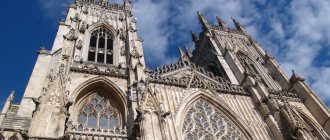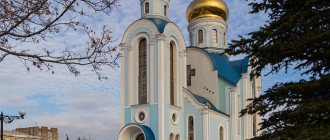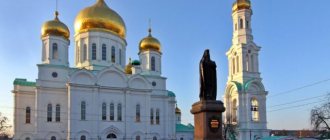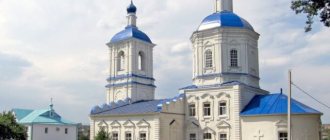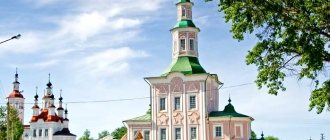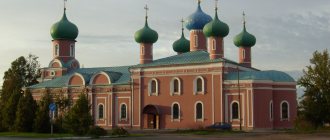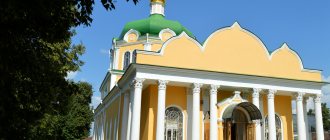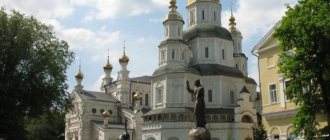| Tambov Transfiguration Cathedral |
Tambov and Rasskazovskaya diocese
of the Tambov Metropolis of the Russian Orthodox Church
- Diocesan administration: Russia, 392000, Tambov, st. Embankment, 80/2
- Tel. (duty), 75-99-89 (reception), 75-99-83 (fax), 75-99-84 (secretary)
- Official site:
- Canonical territory: Tambovsky, Bondarsky, Znamensky, Mordovian, Pichaevsky, Rasskazovsky, Sampursky, Tokarevsky districts of the Tambov region.
- Cathedrals: Transfiguration in Tambov
- On the map: Yandex.Map, Google map
The Great Moscow Council of 1666-1667 decided to elevate the Ryazan Archdiocese to the status of a metropolitanate and create two dioceses within it - Tambov and Voronezh.
In fact, the Tambov diocese was founded only in 1682 by decree of Tsar Feodor Alekseevich. Initially, the diocese included the cities of Tambov, Kozlov (now Michurinsk) and Pavlovsk (now Borisoglebsk). After the occupation of the Tambov see by Metropolitan Stefan (Yavorsky) of Ryazan in 1699, its lands were in fact annexed to the Ryazan diocese. In 1720, the diocese was closed and its lands were transferred to the Voronezh diocese, in 1721 - to the Moscow part of the Synodal Region, and in 1749, partially again to the Voronezh diocese.
In 1758, by decree of Empress Elizabeth Petrovna, the diocese was restored. At this time, in addition to Tambov and Kozlov, the Tambov diocese included the following cities: Dobry, Kerensk, Narovchat, Verkhniy and Nizhny Lomov, Troitsk. In 1764, the boundaries of the diocese expanded. It included the following cities: Penza, Borisoglebsk, Insar, Mokshansk. Since 1779, the following cities were added: Saransk, Morshansk, Kirsanov, Ranenburg, Serdobsk and Chembar.
The final boundaries of the diocese were established by 1803. It did not administratively leave the borders of the Tambov province, approved in 1796.
From 1923 to 1937 there was a renovationist diocese of the same name.
By the end of the 1930s, the Tambov diocese was completely destroyed. There is not a single active parish left on its territory. The restoration of the diocese began in October 1943, when the first church was opened in the city of Tambov. By the end of the Soviet period, the diocese was limited to the Tambov region.
On December 26, 2012, the independent Michurinsk and Uvarovsk dioceses were separated from the Tambov diocese, after which the city districts and the Tambov, Bondarsky, Znamensky, Mordovian, Pichaevsky, Rasskazovsky, Sampursky and Tokarevsky districts in the middle part of the Tambov region remained under the jurisdiction of the Tambov department. At the same time, the Tambov diocese was determined to be the center of the newly established Tambov Metropolis.
Historical names
- Tambov and Kozlovskaya (1682 - 1720)
- Tambov and Penza (April 1758 - October 16, 1799)
- Tambovskaya and Shatskaya (October 16, 1799 - ?)
- Tambovskaya and Michurinskaya (1927 - ?)
- Tambovskaya and Shatskaya (mentioned April 9, 1930)
- Tambovskaya and Kozlovskaya (mentioned September 30, 1931)
- Tambovskaya and Michurinskaya (mentioned January 1944 - December 26, 2012)
- Tambovskaya and Rasskazovskaya (since December 26, 2012)
Statistics
- 1682 – 160 churches [1]
- 1803 - about 900 churches [2]
- 1912 - 1377 churches, 29 chapels; 28 monasteries (12 women’s), 4 women’s communities, 1 monastery courtyard; 1 theological seminary, 4 theological schools, 1 diocesan women's school, 1094 church schools; 1175 libraries at churches; 5 hospitals, 18 almshouses. [3]
- 1917 - about 1,500 churches, more than 3,000 clergy [2]
- 1943 - 1 temple [2]
- 1948 - 49 churches, 109 clergy [2]
- January 1, 1958 [4] - 48 registered temples/houses of worship.
- 1988 - 37 temples [2]
- 2004 - 125 parishes; 145 clergy (134 priests, 11 deacons). [5]
- 2006 - 146 registered parishes in 10 dean districts, of which 24 parishes are located in cities, 16 in urban-type settlements and 106 in villages. [6]
- January 1, 2011 - 6 monasteries, number of inhabitants - 31 (11 monks, 20 nuns), of which 11 were monastics; 172 local Orthodox religious organizations, of which 162 parishes, 6 monasteries, 4 bishops' metochions and the temple of the Tambov Theological Seminary. The number of churches is 138, chapels are 36. The number of clergy: priests is 145, deacons are 12. There are 84 parochial Sunday schools registered in the diocese, and there are 65 Orthodox spiritual and educational centers. [7]
Archpastors
- Leonty (March 26, 1682 - July 1, 1684)
- St. Pitirim (February 15, 1685 - July 28, 1698)
- Ignatius (Shangin) (November 21, 1698 - August 23, 1699)
- Stefan (Yavorsky) (August 1699 - 1720) high, metropolitan. Ryazansky
1720 - 1758 - abolished
- Simon (Lagov) (1887 - 1788), high school bishop. Ryazansky
- Anthony (Sokolov) (December 22, 1811 - March 24, 1812), high school bishop. Voronezh
- Epiphany (Kanivetsky) (May 20 - August 5, 1824), high school bishop. Voronezh
- Ambrose (Morev) (April 14 - August 12, 1841) v/u, bishop. Penza
- Dimitry (Dobroserdov) (September 26, 1923 - 1924) high school bishop. Kozlovsky
- Stefan (Gnedovsky) (1923 - 1926) high school bishop. Kirsanovsky
- Alexy (Buy) (December 1926 - June 29, 1927) high school, bishop. Michurinsky
- Grigory (Chukov) (October 1942 - May 26, 1944) v/u, archbishop. Saratovsky
- Mikhail (Chub) (March 29 - August 8, 1961) diocesan, bishop. Izhevsky
- Pimen (Izvekov) (March 15 - May 10, 1968) supreme, Metropolitan. Krutitsky
- Pitirim (Nechaev) (May 10 - November 28/December 1, 1968) v/u, ep. Volokolamsky
- Seraphim (Tikhonov) (May 14 - September 21, 1985) supreme, archbishop. Penza
- Evgeny (Zhdan) (March 12 - October 11, 2002) supreme, archbishop. Nizhny Novgorod
- Theodosius (Vasnev) (October 11 - December 26, 2002) senior, bishop. Vetluzhsky
In 1758, Empress Elizaveta Petrovna was able to help restore the diocese
In 1758, Empress Elizaveta Petrovna was able to help restore the diocese.
1758
this year Empress Elizabeth participated in the restoration of the Tambov diocese
At that time, the diocese began to include the following cities: Dobry, Kerensk, Narovchat, Verkhniy and Nizhny Lomov, Troitsk. Every year, some cities began to be updated and their list expanded. The boundaries of this diocese were finally established by 1803.
Empress Ekaterina Petrovna was also able to help in the restoration of the Tambov diocese. Photo: regnum.ru
By the 1930s, on the territory of the Tambov diocese there was no longer a single parish that was active. Restoration began in 1943. At that time, the first temple was opened in Tambov. By 1958, there were 47 operating churches in the Tambov region.
It is worth paying attention to the fact that as of 1950, in the Tambov region there were 22.3% of baptized people. Only 8.2% were married in a church, 19.4% of people were buried according to church traditions. During 1957, baptisms in the Tambov region increased.
1964
this year the number of baptisms in the Tambov region reached 53.6%
Already in 1964, the number of baptized people was 53.6%. The number of couples who got married in the temple also increased significantly.
Geography
- Tambov city ():
- Tambov
- With. Theology
- With. Belomestnaya Kriusha, village. Bokino, s. Bolshaya Talinka, village Goreloye, village Donskoye, s. Dubrovka, village Kozmodemyanovka, village Kuksovo, s. Malinovka, village Kuzmino-Gat, village. Pushkari, s. Drakes, p. Soldier's Oven, p. Sagittarius, p. Tulinovka, village Chernyanoye
- r.p. Bondari, s. Verderevshchina, p. Verkhnee Nashchekino, village. Kazyvan, s. Kersha, s. Komarovka, village Korovino, s. Krivopolyanye, s. Maksimovka, s. Arable corner, village. Profits
- Kotovsk, s. Alexandrovka, s. Bolshie Pady, village. Vorontsovka, village Znamenka, s. Izmailovka, s. Karian, s. Pokrovo-Marfino, village. Sukhotinka, s. Tsarevka, village Shakhovka
- r.p. Mordovo, s. Abakumovka, s. Borisovka, s. Vasilyevka, s. Kalinovka, village Lavrovka, village Lavrovo, s. Pavlodar, p. Petrovskoe
- With. Pichaevo, s. 2-Baylovka, s. Bolshoye Sheremetyevo, p. Vernadovka, s. Gagarino-1, p. Egorovka, s. Kanishchevo, s. Lipovka, village Pokrovo-Vasilevo, village. Rudovka
- Rasskazovo, s. Okhtyrka, s. Bolshiye Tulyany, village. Verkhnespasskoe, village Dmitrievshchina, s. Kersha, s. Koptevo, s. Lipovka, village Nizhnespasskoe, village Nikolskoye, village Novgorodovka, s. Osinovka, s. Platonovka, s. Rozhdestvenskoe, s. Podosklai, s. Sayukino, s. Teleshovka
- With. Sampur, s. Bakharevo, s. Belyaevka, s. Verkhotsene, village Ivanovka, s. Panovo-Kusty, village. Petrovka, r.p. Satinka
- R. village Tokarevka
Since 2002, Metropolitan of Tambov and Rasskazovsky Feodosius Vasnev
From December 26, 2002 to the present, the Tambov Metropolis is headed by Metropolitan Feodosius Vasnev of Tambov and Rasskazovsky. Under him, the Tambov Theological Seminary was also created, which continues to operate today and enrolls a huge number of students every year.
Theodosius Vasnev is the current ruling bishop of the Tambov diocese. Photo: drevo-info.ru
Literature
- Khitrov, G., Historical and statistical description of the Tambov diocese
, Tambov, 1861, 342 pp. - Historical and statistical description of the Tambov diocese: With the application of an alphabetical index
, Tambov, 1911, 909 pp., sect. pag., 1 l. kart. - Reference and memorial book on the Tambov diocese on ... [1876, 1902]
, Tambov, 1876-1902. - Dimitry (Sambikin), Lists of persons who completed the course at the Tambov Theological Seminary (1790-1879)
, Tambov, 1879, 218 pp. - Historical and statistical description of the Tambov diocese
. Ed. A.E. Andrievsky, Tambov, 1911
Story
In 1682, Tsar Fyodor Alekseevich, together with the then Patriarch Joachim, decided to create a bishop's see in Tambov - under his leadership were three cities (Tambov, Kozlov and Borisoglebsk) and their deaneries. This decision was dictated not only by the desire to strengthen Orthodoxy in the Don territories, but also to resist the rapidly spreading Old Believers.
Cathedral of the Intercession of the Blessed Virgin Mary in Tambov
The elected bishop began not only to restore abandoned parishes and monasteries, but also to open new ones, which led to a rapid increase in the number of Orthodox Christians throughout the diocese. However, in 1700 its territories lost their independence and came under the control of the Ryazan bishop, in 1720 - the Voronezh bishop, and in 1723 it completely became part of the Moscow Synodal Office.
Only in 1758, Elizaveta Petrovna again endowed the region with its own bishop's see, to which the surrounding cities were subordinated right up to the borders of the Tambov province. The revolution only brought decline to the Russian Orthodox Church; by 1940, there was not a single functioning church left in the entire Tambov region.
Only three years later the first parish was opened in Tambov. Many priests were shot or driven into exile, and there were almost no Orthodox Christians left. But over the course of 70 years, the parishes were gradually restored.
Freedom came with the collapse of the USSR - in the 90s the Tambov diocese was restored, and already in 2012 it had grown so much in the number of parishioners, churches and monasteries that the Holy Synod decided to transform it into a metropolis. And on December 26, 2012, a corresponding decree was issued.
Pitirim Tambovsky built the cathedral of the city of Tambov
Brief life of Saint Pitirim
It is worth paying attention to one of the ruling bishops of the city of Tambov - Pitirim, who ruled the Tambov diocese for a long time. This man paid great attention to the arrangement of monasteries and temples.
He held the Tambov diocese for a very long time. This man was glorified among the saints. His memorial day is celebrated on August 4, August 10.
Icon of Pitirim Tambov. Photo: cs5.livemaster.ru
It is this saint who is credited with the construction of the stone cathedral in the city of Tambov. Currently, the Transfiguration Cathedral houses the relics of St. Pitirim.
There is also an official website of the Tambov Metropolis
Currently, almost every metropolitanate and diocese has its own official website. There is also an official website of the Tambov diocese. It is worth noting that the official website of the Tambov Metropolis and the official website of the diocese of the Tambov region are one and the same website.
Website of the Tambov Metropolis
On the site you can find out news of the Tambov diocese, its history, ruling bishops and bishops, about churches and monasteries that belong to the Tambov Metropolis.
At the beginning of the 20th century, Emperor Nicholas II and John of Kronstadt visited the cathedral
All repair work on the construction of the cathedral and bell tower was completed in 1783. It is worth noting that at the beginning of the 20th century, the cathedral was visited by Emperor Nicholas II himself and Grand Duchess Elizabeth Feodorovna. The well-known holy righteous John of Kronstadt also visited the cathedral.
John of Kronstadt visited the Cathedral of Tambov
Since 1929, the cathedral building began to house a museum. The bell tower was dismantled. At the same time, the cathedral was taken under state protection as a monument. In 1991, they began to think about restoring the shrine.
The main dome was raised, and the relics of St. Pitirim were returned. In 1993, the cathedral was returned to the care of the Tambov diocese. In 1994, a religious community was registered. The bell tower was also recreated from photographs from previous years.
Cathedral of the city of Tambov. Photo: azbyka.ru
Currently, the Transfiguration Cathedral of Tambov is the main cathedral of the city.
By leaving a comment, you accept the user agreement
The construction of the Spaso-Preobrazhensky Cathedral dates back to 1636
At first the temple was purely wooden. Its construction dates back to 1636. It is believed that the temple was built in just 3 months. The holiday was consecrated in 1636 on the day of the Transfiguration of the Lord.
1636
this year, in just 3 months, the Transfiguration Cathedral was built
Priest Mokiy Pozdnyakov was the first rector of the temple. The temple received the status of a cathedral in 1677 by Metropolitan Hilarion of Ryazan. At that time, the temple staff was quite large.
This is how the Transfiguration Cathedral in the city of Tambov currently looks like. Photo: s4.fotokto.ru
In 1682, one bishop was replaced by another - Bishop Leonty. The first thing he did was to cast bells for the bell tower. The new era began from the moment Bishop Pitirim, discussed above, arrived at the temple.
It was he who built the stone Transfiguration Cathedral, which was located not far from the old one. Construction of the cathedral began in 1694.
But, without waiting for its final construction, Pitirim consecrated one of the chapels in the temple in honor of St. Nicholas. It was in this chapel that he himself was later buried.
After the death of Pitirim, the cathedral remained unfinished for a long time. They said that there were no materials for its construction. In 1738, priest Alexander Ulanov was able to find funds to restore the building.
1738
this year priest Alexander Ulanov found funds for the restoration of the Transfiguration Cathedral
But after the death of the priest, it remained unfinished. In 1758, Bishop Pachomius came and found the temple in a very sad state.
By the age of 80, the wooden part of the second floor was severely lopsided. Then Bishop Theodosius began to seek help from local residents. One of the merchants began rebuilding the temple. In 1809, they began to look for funds to build a stone bell tower of the cathedral along with the old wooden one. By 1811 the foundation had been laid.
